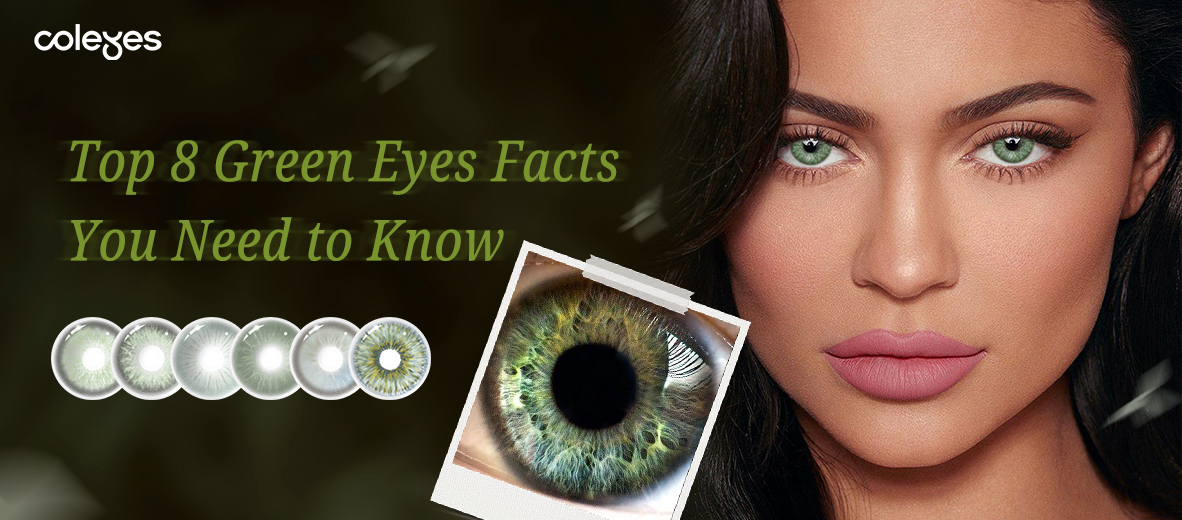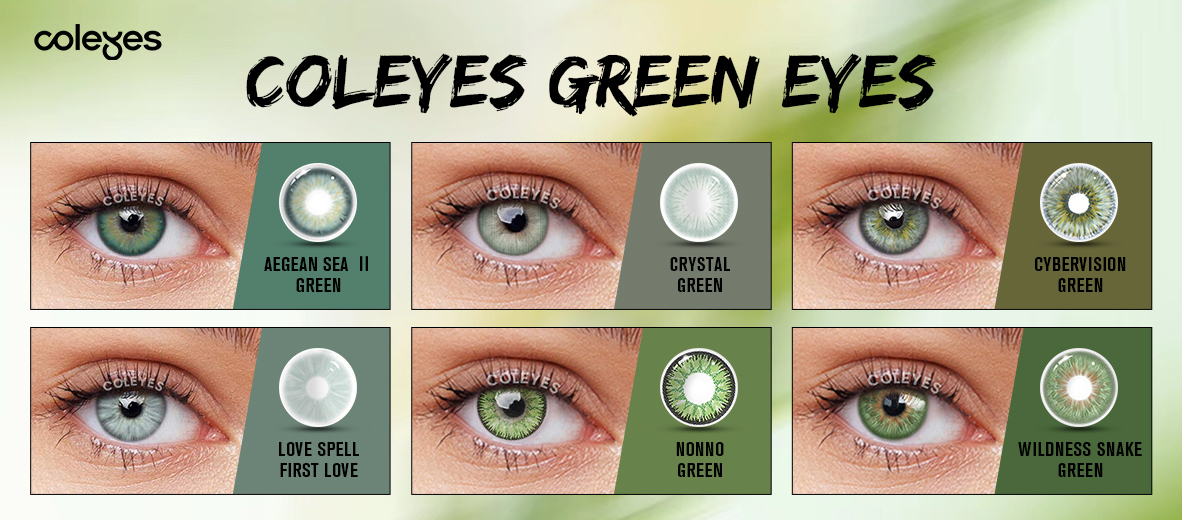Top 8 Green Eyes Facts You Need to Know
Jun 19,2024 | Coleyes

Did you know that only 2% of the world’s population has green eyes? In this article, we’ll uncover 8 fascinating green eyes facts, including their genetic origins, rarity, and the science behind their captivating color. Discover why green eyes are so unique and what makes them special.
Green eyes are extremely rare, comprising only 2% of the global population, and are more common in women than men due to genetic and possibly hormonal factors.
The green eye color results from multiple genetic interactions involving over 16 genes, with significant roles played by the OCA2 and HERC2 genes, and does not involve a specific green pigment but rather the interplay of light and melanin levels.
Individuals with green eyes may face higher risks of certain health conditions like macular degeneration and melanoma of the uvea and should take protective measures against UV exposure to safeguard their ocular health.
Green Eyes Facts:
Imagine a world where the color of one’s eyes could tell a story nearly a decade in the making, influenced by various combinations of genetics, geography, and even sunlight. The green eyes that you might find staring back at you from the mirror or across a crowded room are not just a hue but a tale of ancestry, migration, and even the science of light. Beyond the front layer of the iris, where blood vessels are present, there is a complex narrative woven from the threads of DNA handed down from one ancestor to another.
In the vast canvas of the world, green eyes are like rare emeralds, making up only 2% of the population. These eyes, which can range from the bright green of fresh spring leaves to the deep olives of a Mediterranean landscape, are more than just a color—they are a marvel of genetics and beauty. Interestingly, this trait favors the feminine, with a higher proportion of women graced with this eye color.
As we explore the top 8 fascinating facts about green eyes, we will reveal insights into:
-
The genetics of green eyes
-
The geographic distribution of green eyes
-
The cultural significance of green eyes
-
The rarity of green eyes
-
The variations in shades of green eyes
-
The potential health benefits of having green eyes
-
The myths and legends surrounding green eyes
-
The famous celebrities with green eyes
Why are green eyes so uncommon, and what sets them apart from blue, brown, or hazel eyes? The answer lies in the delicate tapestry of genetics. Unlike brown eyes, which dominate the eye color spectrum, green eyes are elusive, only revealing themselves in about 2% of the global population. This rarity can make green-eyed people feel both unique and misunderstood, as their eye color defies common expectations.
The scarcity of green eyes is even more pronounced when we consider gender differences. It turns out that more women than men possess these naturally green jewels, which could be due to a complex interplay of sex-linked genes or hormonal influences. But what does it take for someone to sport these rare green eyes? Is it the luck of the draw from two blue-eyed parents, or is it something more?
It seems that the rarity of green eyes weaves a tale richer than just the sum of its parts. From the rarest eye color to the most attractive, green eyes hold a special place in our cultural fabric. They can hint at a lineage that carries a rare genetic legacy, or they can be the result of new classifications of eye color genes that science is only now beginning to understand. For green-eyed individuals, their irises are not just a reflection of their genetics but a badge of distinction in a world where common eye colors are the norm.
Genetic Factors Behind Green Eyes
Unlocking the genetic code behind green eyes is akin to unraveling a biological mystery. For a long time, scientists believed that eye color was determined by only one gene, but recent research has painted a different picture. It turns out that the hues of blue, green, and brown in our eyes are shaped by multiple genes—more than 16, to be precise. This intricate genetic network means that the development of green eyes is the result of a symphony of genetic interactions.
At the heart of this genetic dance are the OCA2 and HERC2 genes on chromosome 15, which play significant roles in determining the amount of melanin produced in the iris. Melanin is the pigment that gives color to our skin, hair, and yes, our eyes. But melanin alone doesn’t tell the full story. Other genes, such as TYRP1, ASIP, and ALC42A5, contribute to the pathway that influences melanin distribution, adding depth and variation to eye color.
What’s fascinating is that green eyes are not simply passed down from green-eyed parents. The genetic mutation required for green eyes can occur in a range of combinations, meaning that two blue-eyed parents might be surprised by a green-eyed child. This genetic lottery makes green eyes not just a rare occurrence but also a living emblem of genetic diversity.
The Illusion of Green Pigment
At first glance, one might think green eyes contain a special green pigment that sets them apart. However, if you peer closer, you’ll discover that there is no such thing as a green pigment in the human eye. Instead, the verdant hue we perceive is a clever illusion—a result of the interplay between light brown and yellow pigments and the way cool light dispersing scattering occurs within the eye, known as Rayleigh scattering.
Green eyes possess a chameleon-like quality, often seeming to shift in color with varying emotional states or lighting conditions, from the palest of celadon under cool light to a deep mossy green when dusk falls. This is due to the unique balance of melanin production—green eyes have more melanin than pale blue eyes but less than brown, giving them their distinct look.
This phenomenon is not only mesmerizing but also a testament to the complexity of human biology. So a little melanin, combined with a high concentration of the fat-soluble pigment lipochrome, is responsible for the captivating appearance of green eyes. This delicate balance is what makes green eyes so rare and so sought after, a reminder of the intricate ways our bodies interact with the world around us.
Geographic Distribution of Green Eyes
Have you ever wondered where in the world green eyes are most commonly found? While a mere 2% of the world’s population sport this eye color, certain regions boast a higher concentration of these enchanting irises. Northern Europe and Western Asia have become known as the heartlands of green eyes, with a prevalence that contributes to the allure and mystique of their inhabitants.
In the emerald isles of Ireland and the rugged landscapes of Scotland, green eyes are not an uncommon sight. These countries, along with Iceland, offer a glimpse into a world where green eyes are celebrated and intertwined with cultural identity. It’s as if nature itself has painted these regions with a palette favoring the hue of green, leaving a lasting impression on the genetic makeup of the people.
But green eyes’ geographic tale does not end in Europe. Far from the rolling hills where green eyes are more common, there lies an unusual Chinese village named Liqian. Here, amidst the descendants of an ancient past, green eyes glimmer with a story of historical mingling and genetic marvel. This global distribution of green eyes, found in a small fraction of the world’s population, is a reminder that beauty and rarity know no borders, and sometimes, the most unexpected places can hold the keys to our collective genetic heritage.
Famous Green-Eyed Characters
The allure of green eyes is not confined to reality—it also captures our imagination through the green-eyed heroes and villains that populate our favorite stories. From the pages of comic books to the silver screen, these characters have become symbolic of the mystique associated with green eyes. Some examples include:
-
Marvel Comics’ The Hulk, whose green eyes are as iconic as his superhuman strength and verdant skin

-
The Wicked Witch of the West from “The Wizard of Oz,” whose piercing green eyes add to her menacing presence
-
Loki, the mischievous god from Norse mythology and the Marvel Cinematic Universe, whose green eyes reflect his cunning and unpredictability
Green eyes, as well as blue or green eyes, continue to captivate us with their enchanting and enigmatic appeal, just like gray eyes do. Among these captivating colors, naturally green eyes hold a unique charm that is hard to resist.
The world of superheroes and fantasy is rich with green-eyed figures, each adding their own shade to the spectrum of storytelling. Some examples include:
-
The X-Men’s Rogue and Jean Grey, the latter especially in her Phoenix and Dark Phoenix incarnations
-
The enigmatic Joker from DC Comics
-
Green Arrow
-
Starfire
-
Beast Boy
These characters showcase the enduring fascination with green eyes and the power they hold within our cultural lexicon.
Green Eyes and Attractiveness
The magnetism of green eyes extends beyond their rarity; they also possess a certain je ne sais quoi that often tops the list of attractive eye colors. An online survey by Coleyes revealed that a significant 20.3% of respondents consider green eyes the most attractive, highlighting the universal appeal of this eye color. But what is it about green eyes that captures hearts and holds gazes?
Perhaps it is their scarcity that makes green eyes so intriguing. Being one of the rarest eye colors, they carry an air of exclusivity that naturally draws attention. Or maybe it is their chameleon-like ability to change shades in different lighting conditions that adds to their mystique. Whatever the reason, green eyes have a way of leaving an indelible mark on those who behold them.
The attractiveness of green eyes is not a static trait—it can be influenced by the environment. Lighting conditions, as well as the colors one wears, can enhance or mute the vibrancy of green eyes. This interaction between iris color and the external world creates a dynamic beauty that is both captivating and ever-changing, ensuring that green eyes will continue to be celebrated for their unique charm.

Health Implications for Green-Eyed Individuals
While green eyes may be admired for their beauty, they also come with certain health considerations. Research indicates that individuals with green eyes have a higher risk of macular degeneration, a condition that affects the central part of the retina and can lead to vision loss. Furthermore, green-eyed individuals may be more vulnerable to melanoma of the uvea, the middle layer of the eye.
Other medical conditions associated with lighter eye colors, including green, are basal cell carcinoma and squamous cell carcinoma, types of skin cancer. These risks underscore the importance of protecting one’s eyes from harmful UV rays. The Cleveland Clinic recommends that green-eyed individuals wear contact lenses with UV protection or sunglasses that block 100 percent of UV light to mitigate these health risks.
It’s essential for those with green eyes to be aware of these increased risks and to take proactive steps to safeguard their ocular health. Here are some tips to help maintain the health of those captivating green irises:
-
Schedule regular eye check-ups
-
Wear proper eye protection, such as sunglasses, when outdoors
-
Be vigilant about changes in vision and seek medical attention if necessary
By following these steps, you can ensure the long-term health of your green eyes.
Green Eyes in the Animal Kingdom
The phenomenon of green eyes is not exclusive to humans; it graces the animal kingdom in various forms. Cats, with their enigmatic personalities, are perhaps the most well-known green-eyed creatures. Breeds such as the Egyptian Mau and Russian Blue are celebrated for their intense green gaze, adding to their allure and mystery.
While less common in dogs, there are breeds that exhibit the green-eyed trait, and certain insects are also members of the green-eyed club. These animals, with their diverse backgrounds and habitats, remind us that the beauty of green eyes transcends species, and it’s a trait that captivates us across the natural world.
Summary
As we reach the end of our exploration into the realm of green eyes, it’s clear that this rare eye color holds a special place in our hearts and imaginations. From their genetic origins to their unique ability to captivate and charm, green eyes are more than just a physical trait—they are a window into the diversity and complexity of life itself. They remind us that beauty can be found in the rarity and uniqueness of our individual features.
The journey through the tapestry of green eyes has revealed their global distribution, the iconic characters they inspire, and the allure they hold in the eyes of beholders. We’ve also touched upon the health implications for those graced with this eye color, underscoring the need for care and protection. And let’s not forget our animal companions, who share in the mystique of green eyes, adding their own stories to this colorful narrative.
In a world where the ordinary can often overshadow the unique, green eyes stand out as a testament to nature’s creativity. They inspire poets, artists, and dreamers, and they remind us that in every pair of green eyes is a story waiting to be told, a beauty that defies the common and embraces the extraordinary.

.jpeg?w=650&h=488)
.jpeg?w=650&h=488)
.jpeg?w=650&h=488)